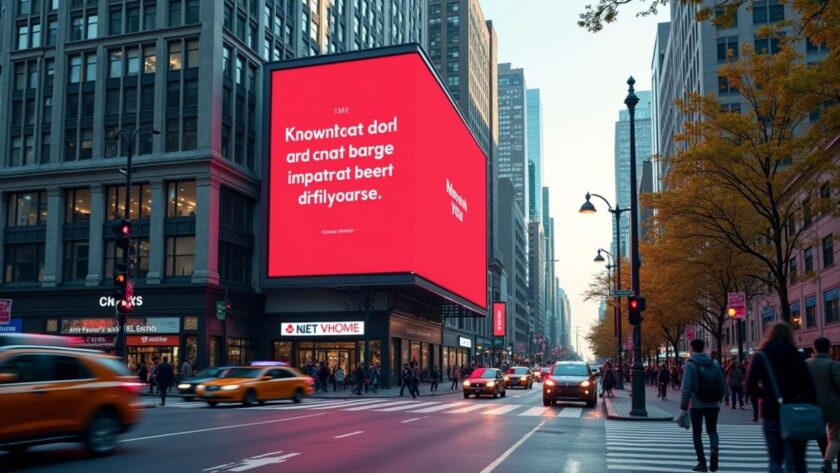In today’s marketing landscape, how does outdoor advertisement still outshine digital efforts? In a world bombarded by social media posts and digital ads, it’s easy for consumers to scroll past even the most eye-catching campaigns. Yet when people step outside and see a bold, compelling billboard or a well-placed poster, it’s nearly impossible to ignore. There’s something about physical ads that can capture attention without competing for the same crowded digital space, and this quality continues to drive results for businesses of all sizes.
Contents
- 1 The Power of Physical Ads in a Screen-Dominated World
- 2 How Tangibility Creates Memorable Impressions
- 3 Bridging Demographic Gaps with Broad Reach
- 4 Strategic Placement That Cuts Through Clutter
- 5 Maintaining Trust While Embracing Innovation
- 6 Overcoming Banner Blindness
- 7 Cost-Effectiveness and Consistency
- 8 Balancing Tradition with Innovation
- 9 Final Thoughts
The Power of Physical Ads in a Screen-Dominated World
Marketers have watched digital noise grow louder each year. With smartphones, laptops, and streaming devices all vying for our eyes, the race to be noticed online can feel overwhelming. Outdoor channels, however, stand apart because they exist where people live and work, mixing seamlessly into the natural flow of daily life. When a billboard or transit ad appears on the commute to work, its message can resonate far beyond a single glance on a newsfeed.
People often appreciate that physical ads are less invasive. Unlike pop-ups or autoplaying videos, a sign on a busy corner waits quietly to be witnessed. Its presence is steady, and this reliability helps build trust in a brand’s message. There’s a subconscious respect for ads that aren’t forced into our personal space, making audiences more willing to engage with the content at their own pace.
How Tangibility Creates Memorable Impressions
Online advertising can be more dynamic, but it also competes with everything from clickbait headlines to family updates. In contrast, physical ads carry a weight that encourages real-world interaction. You can’t minimize an outdoor display or swipe it away when you’re tired of seeing it. This form of advertising compels you to process the message, if only for a moment, which can be enough to spark curiosity or affect purchasing decisions.
The Memorability Factor
Tangibility also leads to memorability. Neuroscientific studies suggest that physical media leaves a stronger recall imprint. When someone observes a creative poster or walks by eye-catching signage, the experience anchors in the brain. This creates a vivid impression that lingers longer than a banner ad lost in an endless digital scroll. Tangible designs, bold typography, and contrasting colors help the mind remember your brand well after the initial encounter.
Bridging Demographic Gaps with Broad Reach
Digital marketing can be precise, but it may unintentionally exclude certain segments of the population. Some individuals use ad blockers, abstain from social media platforms, or simply spend less time online. Meanwhile, outdoor advertisement can reach wide-ranging demographics without discrimination. Whether young or old, digital-savvy or not, consumers spend time outside, traveling, or running errands.
While digital noise focuses heavily on targeted metrics, outdoor placements deliver an immediate sense of inclusivity. People don’t need special apps or devices to see a billboard. This sweeping coverage often leads to organic sharing through word-of-mouth or social media posts, extending the campaign across both online and offline networks. Hence, a strategic poster or roadside banner can spark conversations that ripple far beyond local neighborhoods.
Continuous Brand Reinforcement
A repetitive presence in the physical environment builds strong recognition. When your message is displayed on bus stops, in train stations, or on highways, you’re subtly reminding viewers of your brand at multiple touchpoints. This consistent visibility can be more powerful than digital ads that appear for a split second and vanish with a scrolling motion. Over days or weeks, a well-placed outdoor campaign nurtures brand recall in a way that purely virtual ads often fail to achieve.
Strategic Placement That Cuts Through Clutter
Location is vital when aiming to cut through digital clutter with a more permanent tactic. Placing ads near high-traffic areas, such as busy intersections or popular commercial centers, maximizes exposure. Commuters paused at a red light or waiting for a train have little else occupying their attention, making them more likely to ponder your message. This ambient engagement often translates into higher brand affinity over time.
Brands can also use creative visuals to ensure their outdoor campaigns stand out. Large-scale murals, artistic bus wraps, or interactive kiosks become landmarks within a cityscape. The unexpected design or bold color scheme reshapes the scenery in a memorable way. People come to associate these distinctive placements with your brand, turning your static ad into a conversation piece.
Synergy with Digital Campaigns
Outdoor efforts don’t have to stand alone. Integrating physical ads with your digital strategy can produce a powerful one-two punch. Encouraging passersby to share photos or participate in an online challenge can channel offline engagement into online chatter. This synergy cuts across marketing channels, reinforcing brand awareness at every turn. Instead of relying solely on online metrics, you’re harnessing direct human interaction to amplify your reach.
Maintaining Trust While Embracing Innovation
Trust is a fragile commodity in advertising. Online scams and misleading banners make some users wary of digital promotions. Meanwhile, seeing a brand invest in physical ads adds a layer of perceived legitimacy. People generally assume that if a company is willing to pay for a billboard or a city bus wrap, it’s credible enough to be taken seriously. This sense of solidity can give outdoor campaigns an edge in building consumer confidence.
Still, it’s beneficial to embrace new technology within these traditional formats. Interactive displays equipped with QR codes or augmented reality can bridge the gap between offline and online. A passerby can scan a code for a discount, see a product demo, or access exclusive content. Merging outdoor presence with digital features caters to modern tastes without losing the authenticity earned from tangible media.
Overcoming Banner Blindness
Banner blindness is a phenomenon where people unconsciously ignore anything resembling an online ad. They scroll past them, mentally tuning out the graphics and text. Outdoor advertisement faces fewer obstacles in this regard. A creative wall mural or a well-placed storefront display can surprise and delight viewers who normally skip online ads.
Besides evading banner blindness, these formats can generate authentic word-of-mouth. Tourists snap pictures of impressive murals and share them on social media, effectively doing your marketing for you. Locals may plan outings around new street art, turning your brand campaign into a communal experience. This organic momentum is a powerful antidote to the forced nature of many online marketing tactics.
Evolving with Consumer Habits
Even as consumer habits shift, the flexibility of outdoor ads keeps them relevant. Digital screens in malls and airports can play motion graphics, bringing the energy of online videos to brick-and-mortar environments. Advertisers can update content in real-time, celebrating local events or responding quickly to trends. The longevity of a physical presence, combined with adaptive tech, illustrates why this medium remains so alluring.
Cost-Effectiveness and Consistency
While certain digital channels appear affordable initially, costs can skyrocket with pay-per-click models or constant bidding wars for prime online real estate. A well-placed billboard or a series of transit posters can deliver consistent impressions over weeks or months without draining your daily budget. The cost per impression often competes favorably with many digital formats, especially when you factor in brand recall benefits.
Consistency also sets outdoor mediums apart. Digital ads vanish if your campaign budget runs out, whereas a physical sign stays visible until the contract ends. This reliable exposure helps businesses maintain a consistent presence even during off-peak seasons. For small and large brands alike, that assurance can be invaluable for fostering steady relationships with consumers who pass by regularly.
Strategic Budget Allocation
Balancing outdoor advertisement with digital marketing can optimize your overall advertising spend. Instead of throwing all your resources at online channels, reserving a portion for physical placements can deliver real-world reinforcement. This multi-pronged approach speaks to segments of your audience who may otherwise miss your brand’s message. By spreading your budget wisely, you hedge against rapid changes in online algorithms and trends that can suddenly affect visibility.
Balancing Tradition with Innovation
Outdoor formats have existed for ages, so they bring a sense of heritage into any modern strategy. Yet they’re far from outdated. Creative techniques, interactive billboards, and digital screens have all revitalized this sector. Brands that commit to these platforms show they value lasting exposure and aren’t merely chasing ephemeral online clicks. Such a stance resonates well with consumers who crave genuine, lasting connections.
Emphasizing tradition doesn’t mean ignoring innovation. When you weave new technology into the familiar landscape of physical ads such as using NFC tags or augmented reality it creates a fresh, hybrid experience. This blend of old and new not only sets you apart, but also demonstrates you’re attentive to modern expectations. As a result, audiences see your brand as forward-thinking yet grounded in authenticity.
Final Thoughts
Outdoor campaigns refuse to blend into the background of digital overload. They stand firm on streetscapes, in transportation hubs, and in vibrant city centers. Beyond visibility, these ads benefit from tangibility and community connections that purely online methods struggle to replicate. When paired with evolving tech and integrated wisely into broader marketing efforts, they shine as an essential weapon for any brand aiming to leave a lasting impression.




